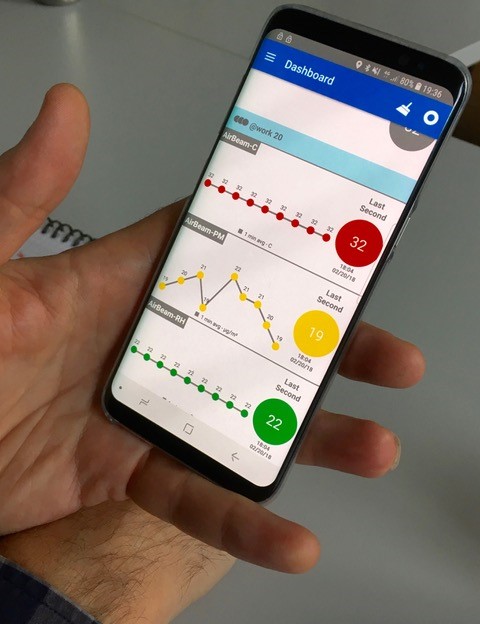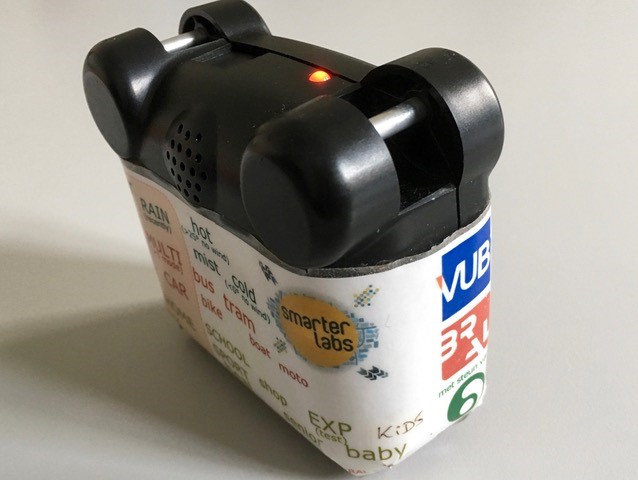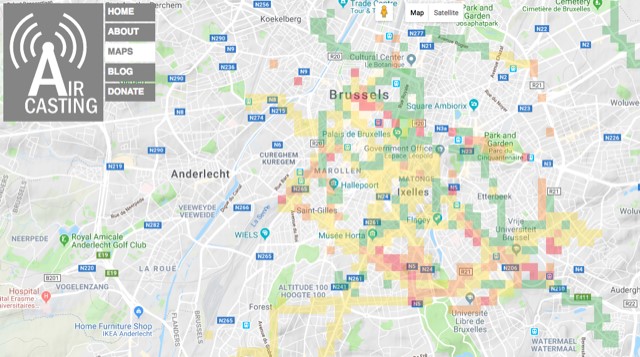Nicola da Schio (Cosmopolis, VUB)
with Arnaud Dubois, Cécile Herr, Katia Xenophontos, Lorenzo Glorie, Matthieu Coulonval.
Pictures: ©FrancoisCorbiau & Aircasting.org
We are thankful to Kobe Boussauw, Evi Dons, and Anna Plyushteva for their useful suggestions.
Background
Air pollution was already discussed by an earlier post of Toxic News. By looking at the examples of Ghent and Antwerp, Thomas Verbeek emphasized (at least) three dimensions that characterise air pollution today: it is an urgent problem, it is a complex one, and it is increasingly being perceived as a priority by citizens around the world (Verbeek, 2017). My research takes place in a similar context, i.e. in Brussels, Belgium, where the question is not whether the city is polluted but how much it is polluted and what are its impacts (for an overview of air pollution in Brussels, see A brief guide to the air of Brussels by da Schio et al. (2017)). This post, in particular, illustrates a citizen science methodology for sketching a series of “exposure portraits” of Brussels’ residents.
The AirCasting Brussels project
Since June 2016, I have been working on AirCasting Brussels. The project took the form of a Living Lab, i.e. a platform of cooperation between my research centre (the Cosmopolis Centre for Urban Studies -VUB), a local community-based organisation (BRAL) and various groups of citizens, to study air pollution in Brussels (to get to know), and to work together toward a cleaner air, mainly through advocacy and awareness raising initiatives (to let others know).
To begin with, the project aimed to respond to questions such as: where are the hotspots of pollution in the neighbourhoods? Who is most exposed? What are the moments during the day when people are the most exposed? To answer these (and other) questions, Cosmopolis and BRAL invited various groups of citizens to participate in a series of workshops for 6-8 months. The groups represented different “communities of interest”, for instance the parents of the children of a certain school, residents of a neighbourhood, employees of a company, members of a local association… Participants were given wearable devices to take measures of air pollution, both to satisfy their own curiosity (e.g. pollution in their garden vs. pollution indoor), and to respond to the group’s collective questions (e.g. pollution in front of the school at drop-off time). The workshops were useful to provide a brief training to newcomers and to exchange the devices among participants, given that less devices were available than interested people. During the workshops, also, participants were encouraged to share their experience and observations, ask questions on relevant issues and try to respond together.
As part of the project the different groups organised activities to share the knowledge with the general public, for instance through public events of experience-sharing and awareness-raising, creative mediatisation of the results, discussion with policy makers, pedagogical activities. The participants themselves would take the lead in deciding what activity was more suitable, given their findings, the local context and their availability. One of the groups, i.e. the “MiniBruxselAirs” initially issued from the Brussels cyclists association, decided to co-author a scientific paper on individual exposure to pollution: L’air d’un Bruxellois, self-portraits of personal exposure to air pollution. This post illustrates the methodology that was developed for it.
Overall, the objective of the paper is to draw a series of portraits of Brussels’ residents, to illustrate their different exposure to air pollution, and to explain the differences on the basis of the different ways they experience the city. The paper, in particular, will explore and illustrate how personal exposure to air pollution can vary significantly between individuals, depending on their habits and routines (i.e. their spatio-temporal geographies); and how -in turn- these different levels of exposure result both from personal choices and from the social and built environment.
Overall, the objective of the paper is to draw a series of portraits of Brussels’ residents, to illustrate their different exposure to air pollution, and to explain the differences on the basis of the different ways they experience the city.
The paper is at the intersect between three strands of research, namely:
- activity-based personal exposure monitoring;
- case-study geographical analysis;
- and citizen science.

Activity-based personal exposure monitoring
Activity-based approaches are usually adopted to cope with one of the main weaknesses of air pollution maps: pollution data at the home address are an insufficient surrogate for personal exposure. Most people, in fact, spend their time in various locations and microenvironments, and each of them is characterised by different levels of air pollution at different times (Panis, 2010). The main feature of activity-based approaches is that they “follow” people through their day and consider the various levels of exposure they are exposed to in various activities. Not only are people exposed to different levels of pollution at different points in time: there are also significant difference between people, precisely because of the different habits and routines they have. In a study on the exposure of eight Belgian couples, for instance, it was observed that personal exposure can vary up to 30% between partners, who live at the same address but have different professional status (in this case full-time workers vs. home makers) (Dons et al., 2011).
To measure activity-based personal exposure, we use the AirCasting infrastructure. This consists of:
- wearable monitors (AirBeams);
- the participants’ smartphones (or smartphones made available through the project, for those who did not have one);
- and the AirCasting website and app (aircasting.org).

The AirBeams are used to collect pollution data (i.e. PM2.5 concentration) and the phones to record them, combine them with GPS and time tags, and upload them to the AirCasting server (see US EPA, 2016; Jiao et al., 2016 for details about the device’s performance). Participants use the AirBeams for periods of 2-4 weeks and record a number of sessions for each of the activities under scrutiny. To allow for a comparison between sessions taken in different periods, the measured data will be ‘corrected’ through a daily correction factor, based on background air pollution measured by the regional network. Personal exposure can change from location to location (e.g. when people get closer to an emission source), but also from day to day, because of the varying background concentration. Including a correction factor would lower personal measurements for days with high background pollution, whilst increasing measurements for days with low background pollution) (see supplemental material of Dons, Int Panis, Van Poppel, Theunis, & Wets, 2012 for a complete explanation).
Case study based geographical analysis
This research is based on a thorough and detailed study of seven cases. Case study analysis is considered to be particularly useful to understand concrete problems, and to incorporate the broad range of contextual influences that help explain a certain phenomenon (in our case air pollution exposure) (Baxter, 2010). A common criticism that is made to this approach is the lack of generalisability, due to a small sample. These criticisms, however, miss a key difference between quantitative and qualitative research. While a quantitative study aims for statistical generalisation and requires a representative (usually large) sample, a qualitative study aims for analytical generalisation (or transferability) making use of a significant sample.
What is important, is to carefully select the cases, and to generate explanations that are neither too abstract, nor too case-specific (Baxter, 2010). Flyvbjerg goes beyond and argues that “generalization, whether on the basis of large samples or single cases, is considerably overrated as the main source of scientific progress” (2006, p. 226). Conversely, concrete, context-dependent, knowledge can even be more valuable than general, theoretical (context-independent) knowledge, inasmuch as it recognises that the human condition cannot be meaningfully understood through general theories and rules – if these theories and rules exist at all in social science!
In our research, the selection of the case studies followed two principles: four of the case studies were made on the project participants themselves, while three additional ones were made on participants’ acquaintances, whose personal situations were emblematic of different situations. To draw a personal exposure portrait, each participant identified four to six “meaningful activities”, i.e. activities that described them and their daily habits. We intentionally opted not to take the same set of activities for all participants, to account for the diversity that exists among people. Finally, participants drafted a description of each of their selected activities, providing a basis for comparison. At a later stage, when the profiles will be drawn and the differences and similarities will start to emerge, more in-depth information exchange will possibly be organized to collect more information on the sociology of the participants, and on the structural and behavioural dimensions of their habits and routines (e.g. by in-depth interviews, focus groups, go-along interviews, diaries…).
Citizen science
The expression ‘citizen science’ typically refers to efforts to enhance the links between the scientific domain and the general public by increasing public participation in carrying out scientific research (very similar concepts are civil, participatory, stakeholder, or democratic science, or lay knowledge, see for instance Bäckstrand, 2011). While there are many different interpretations, in our research we define it as: “the scientific activities in which non-professional scientists volunteer to participate in data collection, analysis and dissemination of a scientific project. […] These activities harness the expertise that exists among those who are traditionally seen as ignorant ‘lay people’ and in general the knowledge of local environments, and knowledge gained through experience” (Haklay 2013; UWE 2013).
Taking a citizen science approach implies a continuous (and intense) process of re-definition of the research objectives and methods, considering all participants’ interests and ambitions, and the available time, skills and technologies. Most of all, though, it means to engage in a research deemed to be relevant and useful in the context of the civic mobilisation of the participants.
Concretely, however, there are many possibilities to conduct citizen science, with different levels of lay people’s engagement, ranging from almost ‘business-as-usual’ science, where participants are engaged as volunteer data collectors, to a more egalitarian approach where they are involved in all stages (Haklay, 2013). Lower levels of participation make it easy to establish a standardised observation protocol, but they do not make use of participants’ capacity to develop and share their own understanding of the matter. Higher levels of participation, which is what we decided to adopt, imply a deeper and more direct engagement between the scientist and the public around topics of shared concern. In our exercise, taking a citizen science approach implies a continuous (and intense) process of re-definition of the research objectives and methods, considering all participants’ interests and ambitions, and the available time, skills and technologies. Most of all, though, it means to engage in a research deemed to be relevant and useful in the context of the civic mobilisation of the participants.
Conclusion
This post presented the methodology of a research project that is still ongoing. The results – possibly available by the end of 2018 – will shed light on how and why different people are exposed to different levels of air pollution. The activity-based measuring method we use will provide a more realistic picture of personal exposure than ambient air pollution levels at the home address. The case-study approach, moreover, will allow to get insights in the reasons behind and the drivers of different exposure levels.
In addition to generating new and more nuanced knowledge on personal exposure to air pollution in Brussels, we believe that the methodology itself is valuable and may be used for similar exercises. The citizen science approach can be useful to raise awareness and train the public about the science of air pollution. At the same time, it can help researchers to reach out a broader audience, through the public events and the greater media coverage, and to learn from different perspectives on their research field. Most importantly, though, the coalition between science and community that is being developed throughout the project carries a great potential in terms of political change, where both scientists and citizens find themselves more empowered in their struggles for a cleaner air. In a historical moment characterised at the same time by a growing scepticism toward science, and yet a (sometimes undemocratic) shift toward technocratic approaches to issues of public interest, testing the potential and the limits of new methods and epistemologies can provide illuminating sparks that cut through the fog.
Bibliography
Bäckstrand, K. (2011). Civic Science for Sustainability: Reframing the Role of Experts, Policy-Makers and Citizens in Environmental Governance. The Postcolonial Science and Technology Studies Reader, 439.
Baxter, J. (2010). Case studies in Qualitative research. In Qualitative research methods in human geography (3rd ed.). Oxford University Press.
Da Schio, N., de Geus, B., & Bouland, C. (2017). A brief guide to the air of Brussels. Brussels Centre Observatory Portfolio #2. Retrieved from http://bco.bsi-brussels.be/a-brief-guide-to-the-air-of-brussels/
Dons, E., Int Panis, L., Van Poppel, M., Theunis, J., & Wets, G. (2012). Personal exposure to Black Carbon in transport microenvironments. Atmospheric Environment, 55, 392–398. https://doi.org/10.1016/j.atmosenv.2012.03.020
Dons, E., Int Panis, L., Van Poppel, M., Theunis, J., Willems, H., Torfs, R., & Wets, G. (2011). Impact of time–activity patterns on personal exposure to black carbon. Atmospheric Environment, 45(21), 3594–3602. https://doi.org/10.1016/j.atmosenv.2011.03.064
Flyvbjerg, B. (2006). Five Misunderstandings About Case-Study Research. Qualitative Inquiry, 12(2), 219–245. https://doi.org/10.1177/1077800405284363
Haklay, M. (2013). Citizen Science and Volunteered Geographic Information: Overview and Typology of Participation. In D. Sui, S. Elwood, & M. Goodchild (Eds.), Crowdsourcing Geographic Knowledge (pp. 105–122). Dordrecht: Springer Netherlands. Retrieved from http://www.springerlink.com/index/10.1007/978-94-007-4587-2_7
Jiao, W., Hagler, G., Williams, R., Sharpe, R., Brown, R., Garver, D., … Buckley, K. (2016). Community Air Sensor Network (CAIRSENSE) project: evaluation of low-cost sensor performance in a suburban environment in the southeastern United States. Atmospheric Measurement Techniques, 9(11), 5281–5292. https://doi.org/10.5194/amt-9-5281-2016
Panis, L. I. (2010). New Directions: Air pollution epidemiology can benefit from activity-based models. Atmospheric Environment, 44(7), 1003–1004. https://doi.org/10.1016/j.atmosenv.2009.10.047
US EPA, O. (2016, August 11). Evaluation of Emerging Air Pollution Sensor Performance [Overviews and Factsheets]. Retrieved July 5, 2018, from https://www.epa.gov/air-sensor-toolbox/evaluation-emerging-air-pollution-sensor-performance
Verbeek, T. (2017, November 7). The environmental impacts of transportation infrastructure: Towards a new relationship between government and citizens. Retrieved July 5, 2018, from https://toxicnews.org/2017/11/07/the-environmental-impacts-of-transportation-infrastructure-towards-a-new-relationship-between-government-and-citizens/
